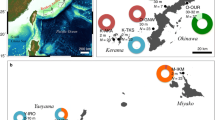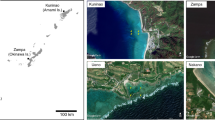Abstract
The identification of different clones is fundamental to the study of population structure among organisms with mixed reproductive modes such as cnidarians. However, due to the low genetic variation of coral mtDNA and contamination by zooxanthellate DNA, very few molecular markers are available for studying the clonal structure of cnidarians. Herein we used four polymorphic loci of microsatellite DNA isolated from a zooxanthellae-free octocoral, Junceella juncea, to study its clonal structure in seven populations collected from three localities in Taiwan. In total, 40 multilocus genotypes were found among 152 colonies, and the number of genotypes (clones) identified in the seven populations ranged from 2 to 16. Each of the 40 multilocus genotypes was restricted to a single population, even where adjacent populations were only 100 m distant. The ratio of observed to expected genotypic diversity (Go:Ge) ranged from 0.217 to 0.650, and Go showed a significant departure from Ge (p<0.05) at each site indicating that asexual fragmentation may play a major role in the maintenance of established populations. Mean relatedness (R) values showed that genotypes within reefs were more closely related than those between regions. The results indicate that microsatellites are useful for discerning the clonal structures among and within populations at different spatial scales.


Similar content being viewed by others
References
Adjeroud M, Tsuchiya M (1999) Genetic variation and clonal structure in the scleractinian coral Pocillopora damicornis in Ryukyu Archipelago, southern Japan. Mar Biol 134:753–760
Ashley MV, Dow BD (1994) The use of microsatellite analysis in population biology: background, methods and potential application. In: Schierwater B et al (eds) Molecular ecology and evolution: approaches and applications. Birkhasuer, Basel, pp 185–202
Ayre DJ (1984) The effects of sexual and asexual reproduction on geographic variation in the sea anemone Actinia tenebrosa. Oecologia 62:222–229
Ayre DJ, Hughes TP (2000) Genotypic diversity and gene flow in brooding and spawning corals along the Great Barrier Reef, Australia. Evolution 54:1590–1605
Ayre DJ, Hughes TP, Standish RJ (1997) Genetic differentiation, reproductive mode, and gene flow in the brooding coral Pocillopora damicornis along the Great Barrier Reef, Australia. Mar Ecol Prog Ser 159:175–187
Benzie JAH, Haskell A, Lehman H (1995) Variation in the genetic composition of coral (Pocillopora damicornis and Acropora palifera) populations from different reef habitats. Mar Biol 121:731–739
Burnett JA, Benzie JAH, Beardmore JA, Ryland JS (1995) Patterns of genetic subdivision in populations of a clonal cnidarian, Zoanthus coppingeri, from the Great Barrier Reef. Mar Biol 122:665–673
Chen CC, Chang KH (1991) Gorgonacea (Coelenterata: Anthozoa: Octocorallia) of south Taiwan. Bull Inst Zool Acad Sin 30:149–181
Chen CA, Wei N-W, Dai CF (2002) Genotyping the clonal population structure of a gorgonian coral, Junceella fragilis (Anthozoa: Octocorallia: Ellisellidae), from Lanyu, Taiwan, using simple sequence repeats in ribosomal intergenic spacer. Zool Stud 41:295–302
Coffroth MA, Lasker HR (1998) Population structure of clonal gorgonian coral: the interplay between clonal reproduction and disturbance. Evolution 52:379–393
Coffroth MA, Lasker HR, Diamond ME, Bruenn JA, Bermingham E (1992) DNA fingerprints of gorgonian corals: a method for detecting clonal structure in a vegetative species. Mar Biol 114:317–325
Dai CF, Fan TY, Yu JK (2000) Reproductive isolation and genetic differentiation of a scleractinian coral Mycediun elephantotus. Mar Ecol Prog Ser 201:179–187
Dieringer D, Schlotterer C (2003) Microsatellite analyzer (MSA)–a platform independent analysis tool for large microsatellite data sets. Mol Ecol Notes 3:167–169
Ellstrand NC, Roose ML (1987) Patterns of genotypic diversity in clonal plant species. Am J Bot 74:123–131
Guo SW, Thompson EA (1992) Performing the exact test of Hardy–Weinberg proportion for multiple alleles. Biometrics 48:361–372
Hamilton MB, Pincus EL, DiFiore A, Fleischer R (1998) Universal linker and ligation procedures for construction of genomic DNA libraries enriched for microsatellites. BioTechniques 27:500–507
Hoffmann RJ (1986) Variation in contributions of asexual reproduction to the genetic structure of populations of the sea anemone Metridium senile. Evolution 40:357–365
Hughes RN (1987) The functional ecology of clonal animals. Funct Ecol 1:63–69
Hughes TP, Ayre D, Connell JH (1992) The evolutionary ecology of corals. Trends Ecol Evol 7:292–295
Hunter CL (1993) Genotypic variation and clonal structure in coral populations with different disturbance histories. Evolution 47:1213–1228
Jackson JBC (1985) Distribution and ecology of clonal and aclonal organisms. In: Jackson JBC, Buss LW, Cook RE (eds) Population biology and evolution of clonal organisms. Yale University Press, New Haven, CT, pp 297–356
Lasker HR (1990) Clonal propagation and population dynamics of a gorgonian coral. Ecology 71:1578–1589
Lasker HR, Coffroth MA (1999) Responses of clonal reef taxa to environmental change. Am Zool 39:92–103
Li Y-C, Korol AB, Fahima T, Beiles A, Nevo E (2002) Microsatellites: genomic distribution, putative functions and mutational mechanisms. Mol Ecol 11:2453–2465
Liu SV, Dai CF, Fan TY, Yu HT (2005) Cloning and characterization of microsatellite loci in a gorgonian coral, Junceella juncea (Anthozoa; Octocorallia; Ellisellidae) and its application in clonal genotyping. Mar Biotech 7:26–33
Magurran AE (1988) Ecological diversity and its measurement. Princeton University Press, Princeton, NJ
Marquez LM, MacKenzie J, Takabayashi M, Smith CR, Chen CA (2003) Difficulties obtaining microsatellites in acroporid corals. In: Proceedings of the 9th international coral reef symp, vol 1. pp 139–143
Miller KJ, Ayre DJ (2004) The role of sexual and asexual reproduction in structuring high latitude populations of the reef coral Pocillopora damicornis. Heredity 92:557–568
Ng WC, Morton B (2003) Genetic structure of the scleractinian coral Platygyra sinenesis in Hong Kong. Mar Biol 143:963–968
Pielou EC (1984) The Interpretation of Ecological Data-A primer on Classification and Ordination. Wiley, New York, NY
Queller DC, Goodnight KF (1989) Estimating relatedness using genetic markers. Evolution 258–275
Raymond M, Rousset F (1995) GENEPOP (version 1.2): population genetics software for exact tests and ecumenicism. J Hered 86:248–249
Stoddart JA (1983) A genotypic diversity measure. J Hered 74:489–490
Stoddart JA (1984) Genetical structure within populations of the coral Pocillopora damicornis. Mar Biol 81:19–30
Stoddart JA, Taylor JF (1988) Genotypic diversity: estimation and prediction in samples. Evolution 118:705–711
Stoddart JA, Willis BL, Heyward AJ (1985) Self-recognition in sponges and corals? Evolution 39:461–463
Willis BL, Ayre DJ (1985) Asexual reproduction and genetic determination of growth form in the coral Pavona cactus: biochemical genetic and immunogenic evidence. Oecologia 65:516–525
Yu JK, Wang HY, Lee SC, Dai CF (1999) Genetic structure of a scleratinian coral, Mycedium elephantotus, in Taiwan. Mar Biol 133:21–28
Yu H-T, Lee Y-J, Huang S-W, Chiu T-S (2002) Genetic analysis of the populations of Japanese anchovy (Engraulidae: Engraulis japonicus) using microsatellite DNA. Mar Biotechnol 4:471–479
Acknowledgements
We thank Drs. C. A. Chen, H. R. Lasker, and two anonymous reviewers for their valuable comments on the manuscript. We also thank Dr. Z. Pasternak for his assistance with statistical analyses and students in H.-T. Yu’s lab for sharing experiences in cloning. This study was supported by a grant from the National Science Council, Taiwan, ROC. (NSC92-2611-M-002-018).
Author information
Authors and Affiliations
Corresponding author
Additional information
Communicated by Biological Editor H.R. Lasker
Electronic supplement: Unique multilocus genotypes (clones) revealed by 4 polymorphic loci for Junceella juncea colonies collected from Xiashuijui (Reefs A, B, C, Transplant, Transect), Nanwan and Shicheng
Rights and permissions
About this article
Cite this article
Liu, SY.V., Yu, HT., Fan, TY. et al. Genotyping the clonal structure of a gorgonian coral, Junceella juncea (Anthozoa: Octocorallia), using microsatellite loci. Coral Reefs 24, 352–358 (2005). https://doi.org/10.1007/s00338-005-0011-7
Received:
Accepted:
Published:
Issue Date:
DOI: https://doi.org/10.1007/s00338-005-0011-7




